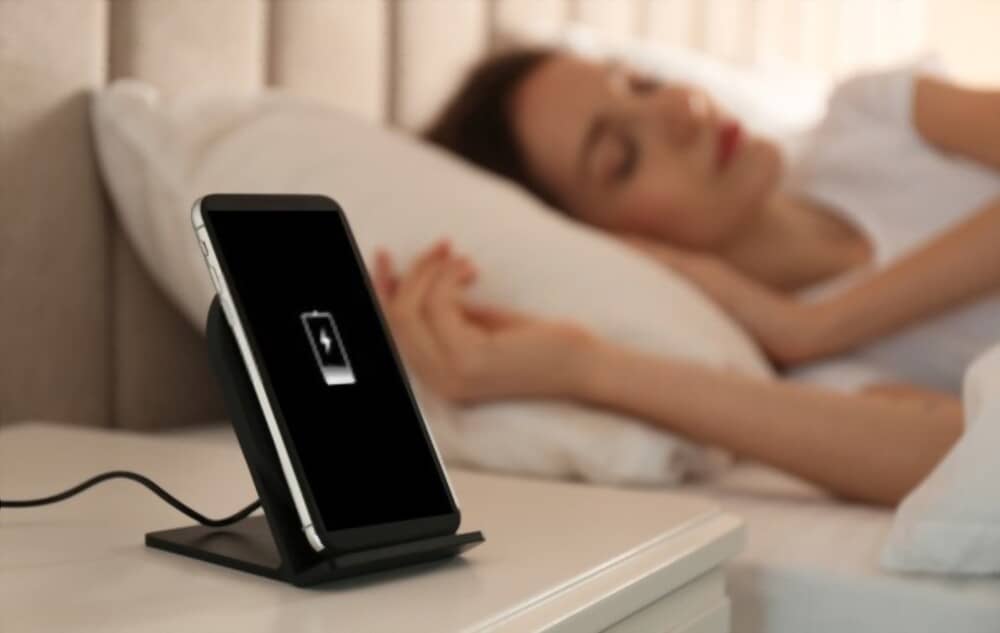Recently updated on February 25th, 2022 at 02:55 pm
The fire risk of a mobile phone battery igniting is at its highest point when the device is being charged. Whether it be from the wall charger or computer, there are many ways to reduce this possibility and prevent an expensive fire.
Here are 35 Ways to Prevent and Reduce the Risk –
1) When charging your electronic devices such as a laptop, tablet, and smartphone; make sure that they are on a flat surface away from any objects that can ignite such as paper products or blankets.
2) Keep all charger’s insight while plugged in so you can see if anything starts smoking or catches fire. This will give you time to unplug it before damage is done to your property and/or personal belongings.
3) Avoid charging your phone overnight. This will reduce the risk of fire from a faulty charger that might overcharge or have frayed wires.
4) Always use the charger that came with your phone. Make sure it is in good condition as this reduces the risk of fire from faulty wires or dangerous materials used to make a knockoff version.
5) Avoid using a power converter or car charger. This can increase the risk of fire if it malfunctions and continues to charge your phone even after you unplug it.
6) Avoid using a charging station. These are often found in public places such as airports, lobbies, and coffee shops where they can pose a fire hazard if plugged into an outlet that is not grounded properly or has faulty wiring.
7) Avoid plugging your phone into an outlet near combustibles such as curtains, bedding, or other fabrics.
8) Avoid plugging into an outlet near a sink or bathtub where water can come in contact with the power source and create a fire hazard.
9) Avoid plugging your phone into an outlet with a blown-out or frayed power cord.
10) Avoid plugging your phone into an outlet where the ground appears to be wet or disconnected from its grounding metal.
11) Do not leave your device charging overnight, especially near bedding and other combustibles.
12) Keep all chargers out of reach of children at all times; never let them play with a charger – even
13) Keep all chargers in a separate room from the area where you’re sleeping.
14) Never leave your device plugged into an outlet while driving, especially if it’s only on standby or not being used at all.
15) Avoid charging during storms as electric currents are often increased and can lead to fires due to arcing (sparks).
16) Avoid charging in an area where the temperature is very cold. This can reduce battery life, and may cause your phone to malfunction or not charge properly.
17) Do not place any combustible materials on top of your phone while it’s being charged.
18) Invest in a fire-proof bag that’s not made of paper that can ignite in an emergency.
19) Take extra care when using a third-party charger or cable, as they are often lower quality and this is one risk where you might want to spend more money for better safety.
20) Never charge your phone while it’s plugged into the wall if there’s any chance of a power surge due to bad weather conditions such as storms; always unplug first!
21) If possible, purchase your own fire guard cover from a company like Otterbox or iON (not just their screen protector). This will provide protection against most fires in case something goes wrong with the plug/socket on the outside.
22) Keep anything flammable away from charging, such as bedding, curtains, or anything else nearby.
23) Keep your phone away from the windows so if it catches fire there’s a better chance of survival for you and others who might be in the house or building at that time.
24) Invest in good-quality batteries to avoid any additional risks associated with cheap brands (make sure they say ‘rechargeable’ on them). No matter how much care is taken when charging, keeping old/defective batteries can cause an increased risk of fire due to manufacturing errors that are impossible to predict.
25) If possible, don’t charge overnight; just plug it in for 30 minutes before going out during periods of bad weather conditions like storms. Leaving it plugged up for too long can cause an increased risk of fire.
26) Be careful when plugging in phone chargers; don’t leave them on top of the bed or anywhere they could be knocked off easily. Plug them into a PowerPoint at least one metre away from anything that might catch fire if it comes into contact with exposed wiring, such as furniture and curtains etc.
27) Always keep your mobile device well ventilated while charging by opening windows/doors to let air circulate around – this will stop any sparks caused by overheating batteries being trapped inside the casing (which is more likely to happen during hot weather). In winter months, make sure you turn off devices before going out so they’re not running for hours after getting back indoors which can lead to your home heating up and causing the fire risk potential.
28) Keep mobile chargers plugged into a socket nearby so you’re not tempted to unplug them every time they become charged – this is an especially risky move if you have pets or small children who could pull on the charger cable while it’s still in use.
29) Carry a portable battery pack with you when traveling, and only run low power devices from mains electricity such as laptops/computers, etc when absolutely necessary (if there are no other options available). This will help prevent any device sparks from being drawn towards people during plugging-in phases which can happen when using high-powered appliances from alternative sources of energy than wall sockets.
30) Make sure you always keep your phone in a case and make sure the charger cable is visible so that you can see it coming out of the back/bottom of your phone.
31) Check for any signs of wear on a battery before charging. If there are cracks or puncture marks, don’t charge the mobile device – even if it still works as normal with low power usage.
32) If you’re not able to access fire extinguisher services when they’re needed most such as during an emergency evacuation), use something else such as baking soda powder mixed in water which will help put out fires due to petrol fumes but will also be less damaging than other substances like sand or ash.
33) If you’re not able to access fire extinguisher services when they’re needed most (such as during an emergency evacuation), use something else such as baking soda powder mixed in water which will help put out fires due to petrol fumes but will also be less damaging than other substances like sand or ash.
34) When carrying anything on the roof of your car, make sure it’s secure and won’t fall off. Never drive with any object on top of the vehicle – this includes objects that are attached at all times like a mobile phone charger cable.
35) Make sure there are no flammable materials around before charging a device.
If your battery starts to swell up:
– Immediately stop the use of the phone, remove it from its case if possible, and place it in a fire-proof bag.
– Take the battery off of your phone or leave it on but remove its metal plate.
– Contact an expert to inspect your device for further damage and determine what steps need to be taken next.
Hope Now You Can Safe Your Phone During Charging. We( Electrician in Boca Raton) Post a Full Blog Post about How to reduce the risk of an electrical problem. Hope This Will Help you too.



